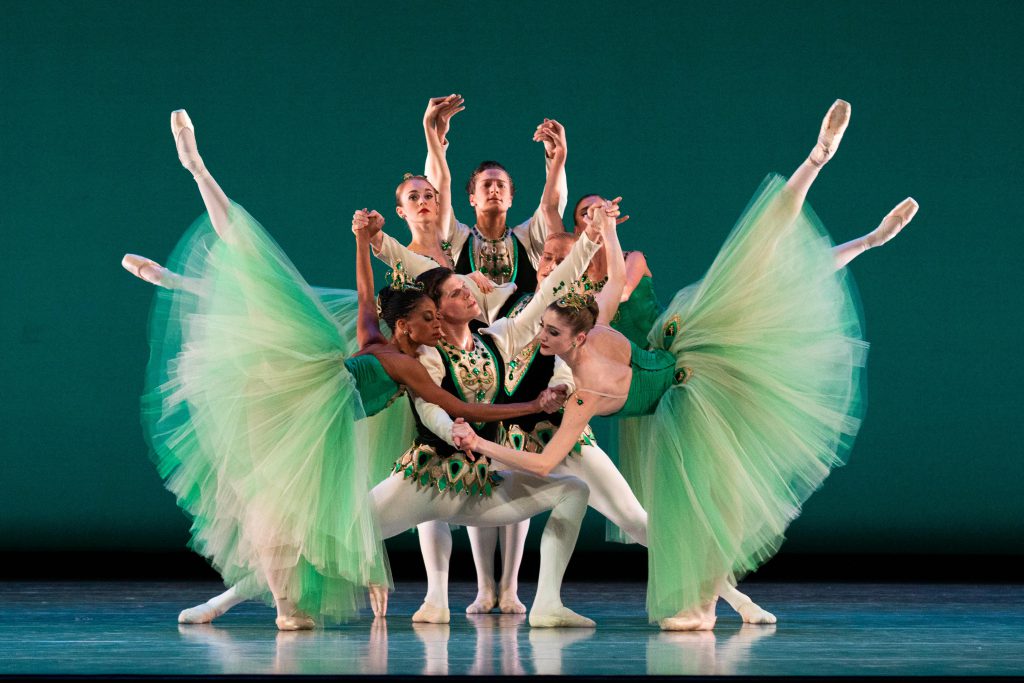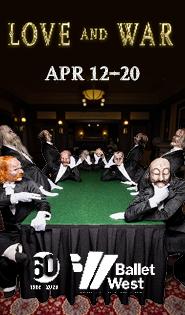Ballet West’s “Jewels” shines brightly and memorably

Ballet West’s “Jewels” runs through November 10. Photo: Beau Pearson
For Ballet West audiences, Jewels is starting to feel like an old friend – pleasant but also familiar.
It seems like only yesterday that Ballet West included Jewels in their programming. It has, in reality, been five years since the company last performed the work in its entirety. But, even after half a decade, Jewels is the kind of ballet that lingers in memory.
Fifty-one years after its New York City Ballet premiere, George Balanchine’s Jewels remains one of the choreographer’s most adored creations. The full-length ballet, comprises three parts –-“Emeralds,” “Rubies” and “Diamonds”—and is also unique in that it contain no narrative. The work is entirely abstract.
This masterful triptych stands out for its uncompromising quality – the lines that Balanchine so skillfully creates on a stage; the movement of dancers like shifting shapes in a kaleidoscope; the style that flows between soft and searing.
The ballet begins in a subdued tone with music by Gabriel Faure (Pelleas et Melisande and Shylock). “Emeralds” is intended to evoke the elegance of France with gentle music and dancers who move with the softness of downy feathers carried on a light wind. Katlyn Addison’s solo exemplified exactly what makes this slow section so lush and breathless. Unencumbered by any partner, nor hidden by a line of other bodies, Addison allowed herself to take each turn, each pirouette, each extension of her arm to its furthest point, resting in suspension. It is in the clarity of the smallest details that “Emeralds” gives its gifts.
After we are nearly exhausted by gentleness, and on the edge of melancholy, we are shocked awake with the manic energy of “Rubies.” Bold, red and jazzy, this is Balanchine’s most American section of the ballet (ironically so, set to Stravinsky’s Capriccio for piano and orchestra). While “Rubies” is a romp, some companies maintain a sense of elegance throughout, though not so for Ballet West. Unafraid to let loose sometimes to a fault, there were moments Saturday night when the high spirits started to look slightly campy – a high-five here and a little too-much extra shimmy there – evoking some audience titters, which is not exactly the kind of response Balanchine wanted.
“Diamonds” hearkens back to the stateliness of the opening act and, befitting of a piece that pays homage to Russia, with far more pomp and circumstance. When the entire cast paraded on stage for the finale (set to Tchaikovsky’s Symphony No. 3) it seemed as though so many dancers came out of the wings they might spill over into the orchestra pit. The main part of “Diamonds” is a sensuous pas de deux that allows both dancers to show the depth of their talent with leaps turns and balances that go far beyond simply turning the ballerina from one pose to another. Omne could not imagine a better pairing than Beckanne Sisk and Chase O’Connell who both brought their finest dancing to the stage.
Artistic director Adam Sklute would do well to keep a number of Balanchine works in the company’s repertoire. Under his guidance over the last decade Ballet West has become a company that does just as well with contemporary ballet as with the classics. For an audience with more conservative tastes, Balanchine offers a safe middle ground that still goes well beyond Swan Lake. And there are so many timeless Balanchine ballets to choose from.
Ballet West’s Jewels continues through November 10. BalletWest.org; 801-869-6900
Katherine Pioli is a Salt Lake City native with a passion for writing and dance. She is the associate editor of Catalyst magazine, a dance writer for the City Weekly and teaches adult writing classes through the University of Utah Lifelong Learning program.

